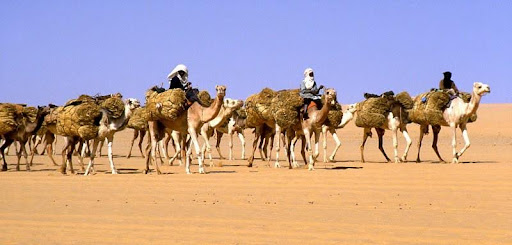Back to: History SSS 1
Hello, my brilliant Afrilearn superstar! I hope you’re having a fantastic day! Have you ever wondered how ancient Nigerian societies connected with the rest of the world before colonialism? Long before Europeans arrived, Nigerian kingdoms and empires had already built strong relationships with people from North Africa and the Middle East. One of the most important ways this happened was through the Trans-Saharan trade.
Today, we will learn about how this trade route influenced Nigeria’s history, economy, and culture.
Early external influences; contact with the North-trans Saharan trade

1. What Was the Trans-Saharan Trade?
The Trans-Saharan trade was a system of trade that connected West Africa with North Africa and the Middle East through the vast Sahara Desert. It was called “Trans-Saharan” because it crossed the desert.
For centuries, traders travelled in large camel caravans, carrying valuable goods across thousands of kilometres. These traders exchanged gold, salt, leather, slaves, textiles, books, and other goods.
The trade played a major role in shaping the history of West Africa, including present-day Nigeria, Mali, and Niger.
2. How the Trans-Saharan Trade Linked Nigeria to the North
Many Nigerian societies, especially in the Hausa and Kanem-Bornu regions, actively participated in this trade. The main groups involved were:
Hausa city-states (Kano, Katsina, Zaria, Gobir, Daura, etc.)
Kanem-Bornu Empire (located in present-day Borno State)
Tuareg and Berber traders from North Africa
These traders helped bring new ideas, goods, and cultures into Nigerian societies.
3. Major Goods Traded Through the Trans-Saharan Route

Different regions specialised in different goods, which made trade essential.
a. Goods Exported from Nigeria to North Africa
Gold (from Ghana and Mali, transported through Hausa cities)
Slaves (captured from wars and raids, sent to North Africa)
Leather (Hausa states were famous for their high-quality leather products)
Kola nuts (used as a stimulant, mainly grown in West Africa)
Ivory (from elephants, used for making ornaments and tools)
b. Goods Imported from North Africa into Nigeria
Salt (a valuable preservative, transported from the Sahara)
Horses (used for warfare and transport by Hausa rulers and warriors)
Silk and textiles (used for making clothes, especially among the wealthy)
Books and Islamic manuscripts (which encouraged literacy and education)
Weapons (such as swords and daggers, used for military purposes)
4. Impact of the Trans-Saharan Trade on Nigerian Societies

The Trans-Saharan trade was not just about buying and selling—it changed Nigerian societies in many ways.
a. Economic Impact
It boosted the wealth of Hausa city-states like Kano and Katsina, which became major commercial hubs.
Rulers and merchants became rich and powerful by taxing goods and controlling trade routes.
Cities like Kano became famous for leatherwork, dyeing, and textile production.
b. Spread of Islam and Education
Islam spread into Northern Nigeria through traders and scholars from North Africa.
Mosques and Islamic schools were built in cities like Katsina, Kano, and Zaria.
Scholars like Muhammad al-Maghili helped spread Arabic writing and Islamic laws in Nigeria.
c. Political Impact
Hausa kings and Kanem-Bornu rulers adopted Islamic laws and governance.
Military power increased as rulers imported horses and weapons from North Africa.
Stronger kingdoms emerged because rulers gained wealth from trade.
d. Cultural Exchange
Islamic architecture influenced the design of mosques and palaces in Nigeria.
The Arabic script was introduced, leading to the development of Ajami writing (Hausa written in Arabic letters).
Hausa and Kanuri people started dressing in North African-style robes and turbans.
5. Challenges of the Trans-Saharan Trade
Despite its benefits, the trade route had several challenges:
The journey across the Sahara was dangerous, with extreme heat, sandstorms, and limited water.
Bandits and raiders attacked caravans, stealing goods and kidnapping traders.
The trade depended on strong kingdoms—whenever a kingdom weakened, trade suffered.
By the 15th century, the discovery of sea routes by Europeans led to the decline of the Trans-Saharan trade, as coastal trade became more popular.
Summary
The Trans-Saharan trade connected Nigeria to North Africa and the Middle East.
It involved the exchange of gold, salt, slaves, textiles, books, leather, and horses.
The Hausa city-states and Kanem-Bornu were the main participants in Nigeria.
The trade led to economic growth, the spread of Islam, political changes, and cultural exchange.
However, it also had challenges like harsh desert conditions, bandit attacks, and the eventual decline due to European sea trade.
Evaluation
- What was the Trans-Saharan trade?
- Name two major Nigerian kingdoms involved in the trade.
- List three goods exported from Nigeria to North Africa.
- How did the trade contribute to the spread of Islam in Nigeria?
- Why did the Trans-Saharan trade decline in the 15th century?
Fantastic job, superstar! Now you know how the Trans-Saharan trade connected Nigeria to the rest of the world. Keep learning, keep growing, and remember—you are part of history too! See you in the next lesson!
